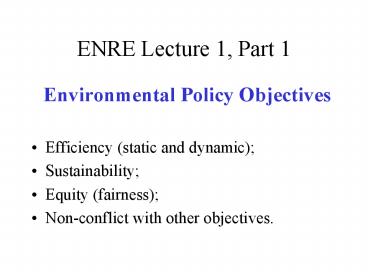ENRE Lecture 1, Part 1 - PowerPoint PPT Presentation
1 / 18
Title:
ENRE Lecture 1, Part 1
Description:
It draws resources from the environment, and provides flows back into the environment. ... First law: Conservation of mass/energy (materials ... Utilitarianism ... – PowerPoint PPT presentation
Number of Views:39
Avg rating:3.0/5.0
Title: ENRE Lecture 1, Part 1
1
ENRE Lecture 1, Part 1
- Environmental Policy Objectives
- Efficiency (static and dynamic)
- Sustainability
- Equity (fairness)
- Non-conflict with other objectives.
2
Economy-Environment Interactions
- Economic activity has a material basis.
- It draws resources from the environment, and
provides flows back into the environment. - These flows must satisfy the laws of
thermodynamics - First law Conservation of mass/energy (materials
balance principle) - Second law Entropy is non-increasing
3
- Environmental resource services and functions
- Waste assimilation and re-processing by
ecological systems - Environmental systems support processes (air,
climate, water, soil) - Provision of productive inputs
- Provision of environmental amenities
- that contribute to labour productivity
- that contribute directly to well-being
4
- Principles of ecology
- The ability of the environmental system to
perform these functions depends on its state of
well-being. - Of relevance here are two central concepts
- Ecosystem stability
- Ecosystem resilience
5
Environment and Ethics Utilitarianism There
are important reinterpretations of that
philosophy which allow for more that merely
narrow self-interested consumer behaviour (see
the work of Sen and Singer, for
example). Alternative ethical frameworks also
exist.
6
Required reading Perman, Ma, McGilvray and
Common Natural Resource and Environmental
Economics (3rd edition) Chapter 1 An
introduction Chapter 3 Ethics and the Environment
7
Sustainability and Sustainable Development WCED
(1987) The most well-known phrase from this
report Sustainable development is development
that meets the needs of the present without
compromising the ability of future generations to
meet their own needs.
8
- Environment - Economy Interactions
- We are interested in
- Reproducibility of each system over time
(sustainability) - Interactions between the two systems
- Predictability or uncertainty in the operations
of these sub-systems
9
Economic sustainability Some economic concepts
of sustainability Sustainability is defined
as... non-declining utility of a representative
member of society for millennia into the
future. A sustainable state is one in which
utility (or consumption) is non-declining through
time. The alternative approach to sustainable
development is to focus on natural capital
assets and suggest that they should not decline
through time.
10
Some interdisciplinary concepts of
sustainability Preserving opportunities for
future generations as a common sense minimal
notion of intergenerational justice Sustainable
activity is...that level of economic activity
which leaves the environmental quality level
intact, with the policy objective corresponding
to this notion being the maximisation of net
benefits of economic development, subject to
maintaining the services and quality of natural
resources over time.
11
- CRITICAL ISSUES
- Critical to sustainability, however defined, seem
to be - the degree of resource substitutability
- the rate of technical progress
- the degree of eco-system stability and
resilience - irreversibility of investment decisions
12
- The degree of resource substitutability
- The assets available to society, now and in the
future, comprise - Natural capital
- Physical capital
- Human capital (labour and embodied skills)
- Intellectual capital (disembodied skills
knowledge - Some of these can be accumulated over time.
Others cannot be they are either finite, or
there are limits to their accumulation. - So, as we move through time, to what extent can
those resources which can be accumulated
substitute for those which cannot (or which are
depleted)?
13
- The rate of technical progress
- Important because technical progress implies we
can get more output from given quantities of
inputs. So limited resources can be stretched
further. - Technical progress may also impact on the extent
of resource substitutability. - And possibly also on the degree of eco-system
stability and resilience.
14
- The degree of eco-system stability and resilience
- Sets fundamental limits to all economic activity.
- Of recent interest in the research literature in
this regard are - biodiversity decline and evolutionary capacity
- interference with natural ecosystems
- Various indicators may signal future
stability/resilience. - But can never know ex ante whether a system is
stable and resilient. - Changes are non linear, and path dependent (so
dependent on initial conditions).
15
FEASIBILITY OF SUSTAINABILITY Is sustainability
feasible? Is it possible for the economy to
attain a state in which production and
consumption track along non-declining paths (or
grow at positive rates) over indefinite periods
of time, in the presence of finite stocks of
exhaustible resources and constraints imposed by
natural environmental processes? Is a huge (and
sometimes technically difficult) literature on
this question. See, for example, the literature
surrounding the so-called Hartwick savings rule.
16
Irreversibility Suppose that an asset is
developed (or used) in some way. New information
arrives and we change our mind about the
desirability of that development. Is it possible
to reverse the process so that we are back in the
original position? Often this is NOT possible. In
those cases, the decision is irreversible This
gives us much less room for making
mistakes. Important in resource valuation.
17
- MODELS OF THE FEASIBILITY OF SUSTAINABILITY
- Much of this based on a neo-classical growth
model with finite environmental resources
examines the possibility of constant consumption
over unlimited time horizons. - Not surprisingly, results depend on assumptions
made about - Resource substitutability
- Technical progress
- Population growth
- It is easy to get specific results for specific
sets of assumptions. - But these are of dubious validity as a guide to
actual policy.
18
Required reading Perman, Ma, McGilvray and
Common (3rd edition) Chapter 2 The origins of
the sustainability problem Chapter 4 Concepts of
Sustainability































